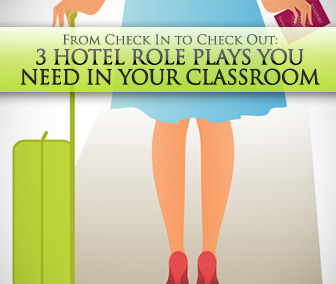5 Fool-Proof Tips for Using Role Play in the English for Tourism Classroom


Speaking English out the classroom is messy and non formulaic, so there is nothing worse than a tourism class where students simply listen to dialogues from a book and repeat them word for word. This practically ensures that your students will immediately forget what they have learned. To ensure that students will remember critical structures, you must create a classroom where dialogues are so full of fun and creativity that it will be impossible for your students to forget them!
One of the main focuses of any English for tourism class should be communication in a hotel situation. Typically, hotels are the hub of the travel abroad experience and, after the airport, hotels are students' first contact with English speakers who probably don't speak their primary language. Below I offer three role plays that can (and should) be used in every English for tourism classroom. What's best is that these three role plays are not just vague ideas; with a small amount of preparation, these guides give you a clear and entertaining lesson plan. These role plays are totally adaptable and can be tailored to any level. Keep it simple for low level students and add more details to the situation to keep higher level students on their toes!

For concierge students, role cards should include a table of hotel information (types of rooms, prices, dates available, etc). For students acting as customers, role cards should include their personal information and specific travel plans. Remember that the more information you use, the more difficult the role play becomes.
You could begin by writing on the board: What should you do before going on holiday? After students have made lists in pairs, feedback as a whole class, making sure that someone adds ‘reserving a hotel room’ to the list. Draw students' attention to this point.
Begin by eliciting what information students need when reserving a hotel room. This list should include things like name, price of the room, how long they'll be staying, etc. Other specific vocabulary should be revised as necessary. For example, types of rooms and things you might find in a typical hotel room. This vocabulary can be revised as a warmer for higher levels or taught more thoroughly for beginning or pre-intermediate classes. Here it might also be appropriate to elicit phrases used in a hotel setting. (“I'd like _____”, “Do you have _____?”, etc.)
The teacher should provide a sample role play worksheet. For elementary or pre-intermediate students, it might be best to provide a full role play. The teacher should go through key structures with the students and also repeat the role play several times in front of the class, practicing pronunciation and intonation. For higher levels such as upper-intermediate or advanced, teachers may be able to simply elicit certain target language and allow students more freedom in their dialogues.
Put students into pairs with the appropriate role cards. Explain that because reserving hotel rooms is typically done over the phone and not in person, they should not face each other so as to simulate the experience of talking over the phone. After your students are back-to-back, have them act out the role play. Monitor carefully, particularly the first time. Make sure that they are inserting the information on their role cards into the dialogue. As you listen, make notes but do not interfere unless a pair has had a total breakdown in communication.
While some teachers might think that students are not interested in repeating role plays multiple times, the opposite is in fact true. Making slight modifications to a situation allows students to repeat critical structures while allowing enough creativity to make the role play different and engaging each time.
In feedback you might want to invite a confident pair to the front of the room to perform their role play. After that, go over any common errors you heard during the production stage.

For students acting as the concierge, role cards should include the customer's personal information, credit card information, and reservation details. For students acting as hotel customers, you should have role cards with slightly different information than that of the concierge; for example, last name “Black” instead of “Block”, incorrect credit card number, etc. Remember: the more information, the more difficult the role play becomes. For lower level classes, include a worksheet with a sample role play as well.
Ask students to think back to their last experience in a hotel. Ask them what they did first. You should be able to elicit ‘check in’. Explain that you will start your hotel unit with a role play involving one student as a customer and the other as concierge.
Explain that students should listen very closely as they check in, as there may be some mistakes. Give one example, such as: “I have a reservation for Jen Black.” “No, I'm Jen Block. That's B-L-O-C-K.” With the whole class, give several mistakes and elicit a correct response.
As with hotel reservations, the teacher should provide a sample role play worksheet or simply elicit / teach useful structures depending on the class's level. In this role play, particularly with lower level students, be sure to emphasize that they should not simply repeat the role play; the structures should be used to create sentences specific to the errors in their particular role cards.
Put the students into concierge / customer pairs. Monitor carefully, particularly the first time they do the role play. Make sure that they are inserting the information on their role cards into the dialogue. As you listen, make notes but do not interfere unless a pair has had a total breakdown in communication.
Be sure to allow each student a chance to act both roles. If time allows, switch pairs and give each new information. This ensures that students understand the structures that they are using (and keeps them from getting bored).

Complaining role plays are quite simple and do not require much preparation. All you will need are role cards. For customers, you should include information like room number, problem, and desired solution. For concierge, you may give some example solutions. With higher level or more creative classrooms you may choose not to use role cards at all and allow students to fully use their creativity.
A good communicative way to introduce this role play is to write several questions on the board, such as What was the worst hotel you ever stayed in? Why? or What problems could you have in a hotel room? After allowing time for students to discuss the questions in pairs, elicit answers to the questions and write them on the board. Remember to teach or elicit any problems they didn't mention. Next you should write another question: What should you do if you have a problem in a hotel? You should be able to elicit complaining from your class. Go over useful complaining structures (“Excuse me, I have a problem”, “I'm afraid that I have a problem with _____”, etc.)
Like the check in role play, the teacher should provide a sample role play worksheet. Go through it with the students several times: drill pronunciation and intonation, discuss any unknown words, and point out the structures that were elicited on the board in the second point. Again: with higher level students it may be appropriate to simply elicit all the key structures you would like them to use and allow them to speak freely, without a written dialogue.
If you chose to use role cards for the complaining role play, hand them out to students and divide them into customer / concierge pairs. Remember to save your corrections until the end of the role play, only interfering if a mistake impedes understanding.
Allow each student to act out each part at least twice, preferably switching partners at least once. This ensures that students will drill the structures thoroughly, but will also have some variation in their dialogues.
The warmer and vocabulary introduction should take about 20 minutes. One round of the role play will probably last for 5-10 minutes and should be repeated several times with changing groups. This leaves time for 3-4 additional dialogues and 10 minutes for feedback.
With 15 minutes of time spent typing up role cards, you can create a lesson that is low preparation for you, and engaging and memorable for your students.
Tried any of these role plays? How did students respond? Please let us know in the comments below!